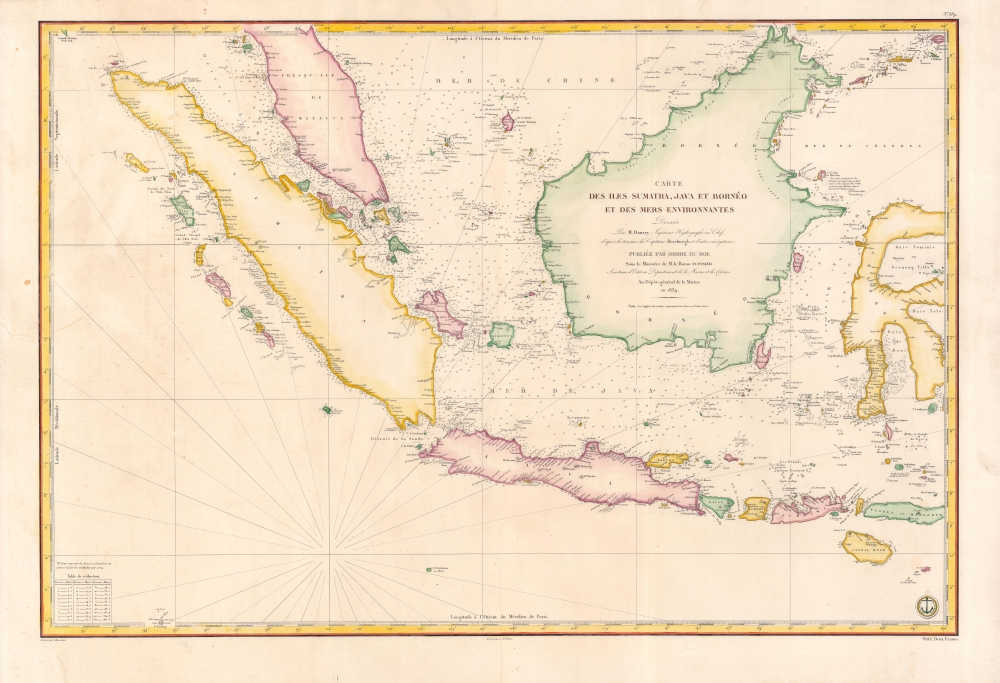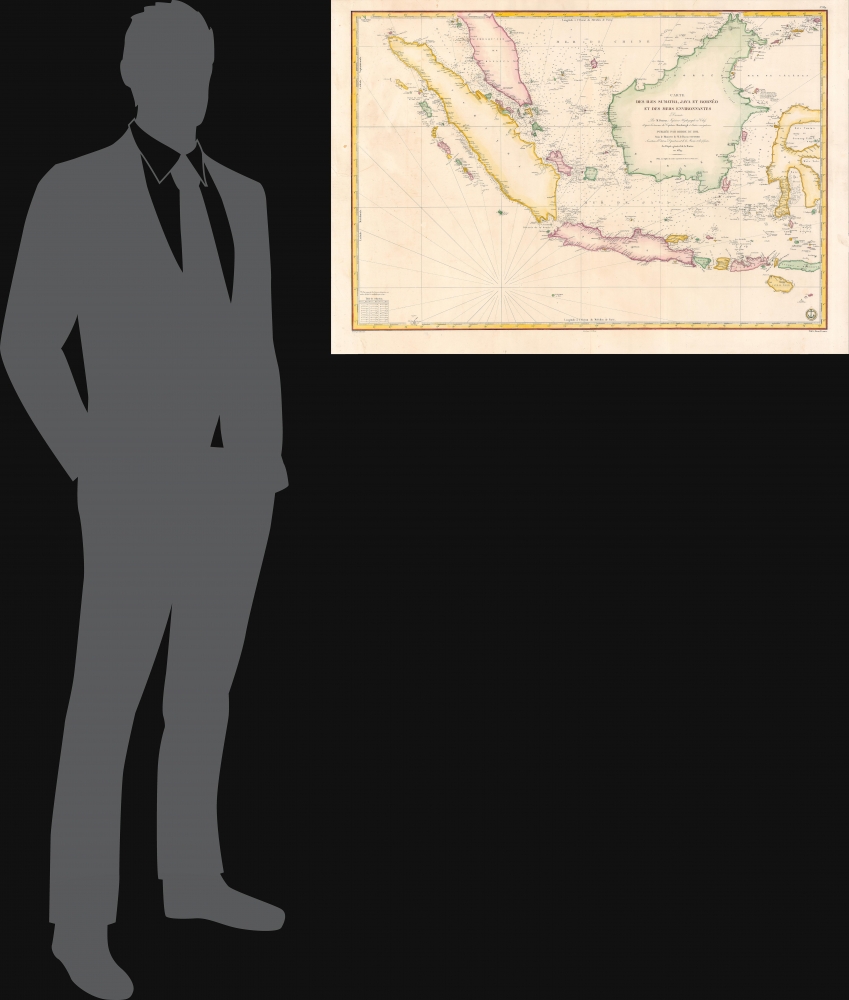1839 Depot de la Marine Map of the East Indies: Malay, Singapore, Java, Sumatra, Borneo
EastIndies-depot-1839
Title
1839 (dated) 23 x 34.5 in (58.42 x 87.63 cm) 1 : 4060000
Description
A Closer Look
Based upon the work of the British hydrographer James Horsburgh, namely his groundbreaking work Directions for sailing to and from the East Indies, China, New Holland, Cape of Good Hope, and the interjacent ports, this elegantly hand-colored map covers Sumatra, Java, and Borneo in full, as well as Malay (Malacca) south of Lancava and parts of the Celebes. It further specifically includes the islands of Singapore (Sincapoor), Bali (Bally), Lombok (Lombock), Krakatoa (Crockatoa), and Komodo (Comodo).Soundings, anchorages, shoals, hazards, and supplementary information on currents, longitude, latitude, and more are indicated. Soundings are measures in brasses, a French unit popular at the time roughly similar to a fathom; a table of conversion to meters is provided at bottom-left. Islands, coastal settlements, and other landward features are noted in fantastic detail.
Publication History and Census
This chart was prepared by Pierre Daussy in 1839 based on the hydrography of James Horsburgh, engraved by Chassant (no given name known), with text by Jacques-Marie Hacq, under the direction of the Dépôt-général de la Marine. The map was reissued several times through the 1880s with updates and additions, but the date of 1839 and other identifying information (such as 'No. 889' in the top-right corner) remained, leading to a high degree of variation in cataloging which makes a comprehensive census difficult. This edition, presumably the first as it is the least accurate, differs from more widely available examples in several respects, such as the representation of Singapore and the small islands south of Celebes. Nevertheless, in any edition this chart is quite rare, especially with such exquisite hand-coloring.CartographerS
Dépôt des Cartes et Plans de la Marine (fl. 1720 - present), often called the Dépôt de Marine, was a French hydrographic mapping organization founded in 1720 under Charles-Hercule of Albert de Luynes (1674 - 1734). Much like the U.S. Coast Survey, the British Admiralty, and the Spanish Deposito Hydrografico, the Dépôt was initiated as a storehouse and distribution center of existing nautical and marine charts. Eventually the Dépôt initiated its own mapping activities in an attempt to improve and expand upon existing material. Some of the more prominent cartographers and hydrographers associated with the of Dépôt des Cartes were, Philippe Buache, Jacques-Nicholas Bellin, Giovanni Rizzi-Zannoni, Rigobert Bonne, and Jean Nicolas Buache. More by this mapmaker...
Pierre Daussy (October 8, 1792 - September 5, 1860) was a French astronomer and hydrographic engineer with the Bureau des Longitudes and later the Dépôt des Cartes et Plans de la Marine, which he led as Director in the years prior to his death. Daussy was born in Paris, the son of hydrographer Magloire Thomas Daussy (1758 - 1826). He followed in his father's footsteps, studying at the École des Ingénieurs Hydrographes before undertaking hydrographic work in the North Sea under the command of Charles-François Beautemps-Beaupré. He graduated to the rank of engineer in 1819 and chief engineer in 1829. In 1833, he began work with the Bureau des Longitudes correcting the French Table des Positions Géographiques des Principaux Lieux du Globe to conform with the most recent measurements made possible by new hydrographic instruments and methodologies. He was elected Director of the Dépôt des Cartes et Plans de la Marine in 1855. He also served as the President of the Société de Géographie de Paris in his later years and published several works on hydrography and navigation, particularly relating to the coasts of the Ottoman Empire and Persia. Learn More...
James Horsburgh (September 28, 1762 – May 14, 1836) was a Scottish hydrographer and navigator active in the late 18th and early 19th century. Horsburgh was born in Fife, Elie, Scotland, to a humble family. Like many young Scottish men of little means, Horsburgh was destined for a sea-faring life and at just 16 signed on as a cabin boy in a coal trading ship. After many misadventures, including a brief incarceration by the French at Dunkirk, Horsburgh made his way to the West Indies and eventually to Calcutta, India. As the center for British maritime trade in the region, Horsburgh had no difficulty finding work with the British East India Company who maintained an active trade network between India and China. Despite the regular trade, one these voyages to China, aboard the ironically named Atlas, taught Horsburgh just how poorly the East Indies were charted. The 1786 shipwreck of the Atlas, on which he was the First Mate, near Diego Garcia Island proved a pivotal moment Horsburgh's life. He subsequently devoted himself to accurately charting the Indian Ocean and the dangerous Straits of Malacca, Sunda, and Singapore. Many of Horsburgh's charts are the direct results of his own unique survey work on board the Carron and later as captain of the Anna. Horsburgh's work culminated in the publication if his 1809 Directions for Sailing to and from the East Indies, China, New Holland, Cape of Good Hope, and the Interjacent Ports, a monumentally important guide to navigating the waters of the Indian Ocean and the East Indies. His work earned him friendships in London's highest naval and scientific circles, among them Joseph Banks and Alexander Dalrymple. He became a member of the Royal Society in 1806, when he retired from active sailing. When Alexander Dalrymple died in 1810, Horsburgh was appointed to the prestigious position of Hydrographer to the British East India Company where he worked until his death in 1836. Whereas Dalrymple was somewhat indiscriminate regarding the charts he published, Horsburgh was exacting and double checked the veracity of each and every chart that passed through his office. Horsburgh's work with the East India Company elevated the standards of the Hydrographic Department and earned him a Fellowship with the Royal Society. Today's Horsburgh's accomplishments are memorialized by the Horsburgh Lighthouse, near Singapore, and Horsburgh Island. When Horsburgh died most of his work was passed by his children to the Admiralty, which continued to publish updates until roughly 1864. Learn More...
Jacques-Marie Hacq (September 22, 1785 – 18??) was a French letter and line engraver, and historian, active in Paris during the middle part of the 19th century. Hacq was born in Paris and trained under J. P. Besançon, who he succeeded at the Dépôt de la Guerre in 1830. He engraved for the Dépôt de la Guerre as early as 1830 and for the Dépôt des Cartes et Plans de la Marine from, at least, 1840 to 1852. In addition to his work for the French Government, he also completed maps and engravings for Lesage, Lapie, Dufour, Duperrez, Gouvion St. Cyr, and Dumont d'Urville. His historical works include a history of the Napoleonic Wars and a history of Paris under the reign of Louis XIII. During most of his career in Paris he lived at 58 Rue de la Harpe. Learn More...
Chassant (fl. c. 1830 - 1860) was a French line and chart engraver active in Paris in the middle part of the 19th century. Chassant was active with the French Dépôt de Marine from the 1830s into the 1860s. He was a master engraver and, some have argued, his dramatic hachuring work to illustrate topography suggests he may have been wasted on nautical charts. Most of his engraving was completed in partnerships with Jacques-Marie Hacq (September 22, 1785 – 18??). Chassant did not sign any of his engravings with a first name or other identifier, so it is difficult to track him down. He may be Alphonse Antoine Louis Chassant (August 1, 1808 - September 7, 1907), who in later life was an art historian and librarian of the city of Évreux. He wrote several books, including works on engraving. We cannot alas verify the connection and it may be pure guesswork. Learn More...




